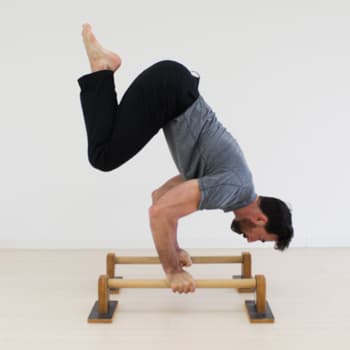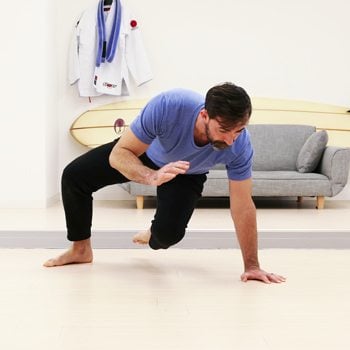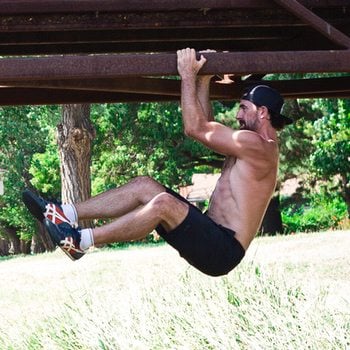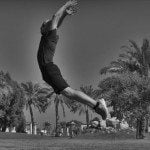Imagine never doubting yourself physically. Always being up for activities as experiences present themselves. Waking up everyday without any worries about nagging pains or limitations. Instead, you feel anticipation for the possibility of fun and exploration in the day ahead.
That feeling is what we call “physical autonomy,” and it’s something you’re probably striving for, whether you realize it or not.
Physical autonomy comes from knowing you’ve built the attributes you need so that your body is fully prepared for the activities you care about, as well as the unknown.
In this article I’ll show you how you can start building physical autonomy right away.
The 3 Attributes Necessary for Physical Autonomy
The primary attributes common to all of training are Strength, Flexibility, and Control. These three are all addressed in varying degrees in your workouts. It simply depends on your emphasis.
1. Strength

This is easy and intuitive to understand.
Lifting heavy boxes when you help your friends move, carrying all of your luggage through the airport, or being able to do fancy bodyweight moves like the human flag and the planche–These are all obvious and relatable examples of a good level of strength.
You can pick up or push heavy things around better. And in the case of bodyweight movement you can move yourself around easier because you are stronger.
But strength contributes to your physical autonomy as long as you’re building the strength you need for the particular goals you have.
2. Flexibility

Good flexibility is easy to see, whether it’s being able to bend forward to touch your toes, bend backward into a bridge, putting your leg behind your head, or simply being able to reach up to scratch that itch on your back.
You can call it flexibility or mobility or whatever you want. But honestly, it’s the ability to move your limbs and trunk with a sense of freedom.
If you can’t get into a position that you want, then you’ll need to find a way to get there.
3. Control

This concept is a bit more difficult to see in a concrete way. But it has within it balance, coordination, and agility.
Control includes all those things that we see people do in sports and dance and performance and we know they are great because they look smooth and graceful and are able to move their body in such amazing ways.
From making a ridiculous leaping catch in baseball, to the volleyball player pulling off an incredible diving save, and to the remarkable gymnasts we see in the Olympics, we all know it when we see it.
Strong, flexible, and with control over every aspect of your body movement–sounds great to me! It’s a tall order but not out of reach.
How to Work Toward Physical Autonomy

Answering this question will help guide you toward physical autonomy.
What does it take then to achieve this freedom, the unrestrained choices of action and doing that identifies your physical autonomy?
First you need to take a true stock of your current abilities.
- What are you already capable of doing well?
- And what could you stand to make better?
Now that we’ve identified the three main attributes of physical fitness, you can analyze how well you manage in each aspect.
Our colleague Brett at Art of Manliness shared a missive by Earle Liederman about his standards for physical fitness that every man should have, so as to “save his own life in an emergency.” Abilities such as being able to do 15 to 20 pullups, jump higher than your waist, and swimming a half mile, are cited as exemplar skills of a well developed man capable of handling himself in any predicament.

And others have added their two cents: being able to press your bodyweight overhead, pick a few hundred pounds off the ground, etc. I’m sure you could come up with your own standards based on your own daily experiences as well.
Really, these “just in case” kinds of strengths and abilities are basically another way of characterizing our primary concern–being able to do what we want and need to do in all our daily lives.
Basic Assessments of Your Abilities
- For strength, can you spend a day rearranging your garage and still be able to move normally the next day?
- Flexibility-wise, can you squat down and crawl under your bathroom sink to fix a broken nut without feeling like you are going to rip your hip muscles apart?
- For body control, can you reach up on your toes on one leg to grab the rarely used serving dishes without falling over and breaking them (or yourself)?
These are the practical benchmarks that mean more than any arbitrary standard a fitness guru wants to force upon you. Of course these are all very individualized concerns, and one person would have different needs based on his life situation, while another would have specific requirements for her job and home life.
Take a moment to consider your needs for your day-to-day life, and also your personal goals. What is it that you need and want to do? You know more than anyone what drives you.
With this in mind, your progress towards Physical Autonomy then hinges on whichever of these three are the limiting factors. Spend time shoring up your deficiencies and you’ll likely see immediate improvements in how you move.
Physical Autonomy in Action

If your flexibility is what’s holding you back, then focus on that for a while before working on other attributes.
Once you’ve determined what is best for you to focus on, and the qualities you need to improve to boost your physical independence, now you need to work on them!
This doesn’t require a drastic change in what you are already doing. Well, unless you aren’t doing anything…
Sweeping alterations in your current program can change so many variables you won’t know what in particular helped out the most. Instead, simple additions and substitutions in your current regimen, to address your specific attributes that need work, will add up to big dividends in your performance.
The answer to an improved physical autonomy plan doesn’t mean doing a little of everything and hoping for the best. It’s a series of targeted plans that emphasize a part of what you need the most, then moving on to the next as you maintain what you worked on before.
“You can have it all, just not all at once.”

Your ideal session should have a primary focus of your energy and time, with some time spent on the other two attributes, along with some movement exploration.
This concept of emphasizing one aspect but not neglecting the others is an advanced way of thinking of programming, and one that you’d likely hit upon before, even if you didn’t purposefully plan it as such.
It just makes sense to spend your energies on certain priorities while you put the others on simmer.
You can try and train everything separately, then work on pulling it back together later on. But that’s not the most efficient way. The trouble with compartmentalizing in this respect is that physical autonomy is a true wholism.
The essential nature of physical autonomy is the integration of the primary attributes into how you move your body.
Your strength, flexibility, and control are manifest in the actions you want to perform. That means they aren’t sequestered or insulated from each other. Instead, it’s the natural mixture of the attributes that comprise skilled movement performance.
An Example of Integration of Attributes
In this video you see Ryan working on a movement chain for the shoulders in our Unbreakable article series for short and effective routines for improving resilience in choice body areas. They are meant as complements to your main training scheme.
The different attributes of strength, flexibility, and control are all apparent in this video and are an example of pulling them all together.
This movement sequence can be used as a supplement to your primary training, giving you a chance to spend a few minutes in your daily training to actually practice your burgeoning physical autonomy.
You aren’t spreading yourself thin and trying to “do all the things!” Instead, you are choosing to expend your energies wisely, with most of it on your primary focus and small amounts on what you would like to maintain.
Gain Freedom With Your Body
 Physical autonomy may be a different way of describing it, but the heart of it has likely been part of the deeper motivation in your training. You want to have the freedom to do the things you want to do, and it helps to have a body that helps you toward that.
Physical autonomy may be a different way of describing it, but the heart of it has likely been part of the deeper motivation in your training. You want to have the freedom to do the things you want to do, and it helps to have a body that helps you toward that.
When you’ve worked on the attributes that make physical autonomy possible, you’ll not only be able to do the things you want to do, but you’ll also have the freedom to make choices about your path that you wouldn’t otherwise be able to.
For example, if rock climbing or snowboarding weren’t activities you could even consider before, they become one more activity that’s open to you.
To work toward that sense of physical autonomy, it’s important to fully understand what attributes you need the most work on, so that you can spend your time developing them.
Our Elements course not only helps you build a foundation in strength, flexibility, and control, but after going through the program, it also gives you a deep understanding of where to place your focus. This helps you direct your next training cycle to what you need most.
Build Physical Autonomy With a Foundation in the Basics
With Elements, you’ll build a foundation of strength, flexibility, and control, setting yourself up for a successful lifetime of staying fit and active.




